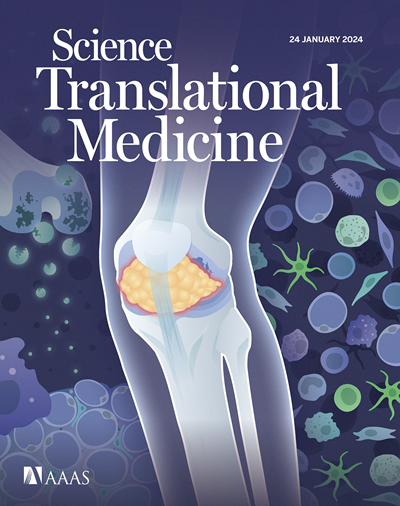In vivo CRISPR activation screen identifies acyl-CoA–binding protein as a driver of bone metastasis
IF 15.8
1区 医学
Q1 CELL BIOLOGY
引用次数: 0
Abstract
One of the most common sites of cancer metastasis is to the bone. Bone metastasis is associated with substantial morbidity and mortality, and current therapeutic interventions remain largely palliative. Metastasizing tumor cells need to reprogram their metabolic states to adapt to the nutrient environment of distant organs; however, the role and translational relevance of lipid metabolism in bone metastasis remain unclear. Here, we used an in vivo CRISPR activation screening system coupled with positive selection to identify acyl–coenzyme A (CoA) binding protein (ACBP) as a bone metastasis driver. In nonmetastatic and weakly metastatic cancer cells, overexpression of wild-type ACBP, but not the acyl-CoA–binding deficient mutant, stimulated fatty acid oxidation (FAO) and bone metastasis. Conversely, knockout of ACBP in highly bone metastatic cancer cells abrogated metastatic bone colonization. Mechanistically, ACBP-mediated FAO increased ATP and NADPH production, reduced reactive oxygen species, and inhibited lipid peroxidation and ferroptosis. We found that ACBP expression correlated with metabolic signaling, bone metastatic ability, and poor clinical outcomes. In mouse models, pharmacological blockade of FAO or treatment with a ferroptosis inducer inhibited bone metastasis. Together, our findings reveal the role of lipid metabolism in tumor cells adapting and thriving in the bone and identify ACBP as a key regulator of this process. Agents that target FAO or induce ferroptosis represent a promising therapeutic approach for treating bone metastases.
体内CRISPR激活筛选鉴定酰基辅酶a结合蛋白作为骨转移的驱动因素
最常见的癌症转移部位之一是骨。骨转移与大量发病率和死亡率相关,目前的治疗干预措施在很大程度上仍然是姑息性的。转移性肿瘤细胞需要重新编程其代谢状态以适应远端器官的营养环境;然而,脂质代谢在骨转移中的作用和翻译相关性尚不清楚。在这里,我们使用体内CRISPR激活筛选系统结合阳性选择鉴定酰基辅酶A (CoA)结合蛋白(ACBP)作为骨转移驱动因子。在非转移性和弱转移性癌细胞中,野生型ACBP的过度表达,而不是酰基辅酶a结合缺陷突变体的过度表达,刺激了脂肪酸氧化(FAO)和骨转移。相反,在高度骨转移的癌细胞中敲除ACBP可消除转移性骨定植。机制上,acbp介导的FAO增加ATP和NADPH的产生,减少活性氧,抑制脂质过氧化和铁下垂。我们发现ACBP表达与代谢信号、骨转移能力和不良临床结果相关。在小鼠模型中,药物阻断FAO或用铁下垂诱导剂治疗可抑制骨转移。总之,我们的研究结果揭示了脂质代谢在肿瘤细胞在骨中的适应和生长中的作用,并确定ACBP是这一过程的关键调节因子。靶向FAO或诱导铁下垂的药物是治疗骨转移的一种很有前途的治疗方法。
本文章由计算机程序翻译,如有差异,请以英文原文为准。
求助全文
约1分钟内获得全文
求助全文
来源期刊

Science Translational Medicine
CELL BIOLOGY-MEDICINE, RESEARCH & EXPERIMENTAL
CiteScore
26.70
自引率
1.20%
发文量
309
审稿时长
1.7 months
期刊介绍:
Science Translational Medicine is an online journal that focuses on publishing research at the intersection of science, engineering, and medicine. The goal of the journal is to promote human health by providing a platform for researchers from various disciplines to communicate their latest advancements in biomedical, translational, and clinical research.
The journal aims to address the slow translation of scientific knowledge into effective treatments and health measures. It publishes articles that fill the knowledge gaps between preclinical research and medical applications, with a focus on accelerating the translation of knowledge into new ways of preventing, diagnosing, and treating human diseases.
The scope of Science Translational Medicine includes various areas such as cardiovascular disease, immunology/vaccines, metabolism/diabetes/obesity, neuroscience/neurology/psychiatry, cancer, infectious diseases, policy, behavior, bioengineering, chemical genomics/drug discovery, imaging, applied physical sciences, medical nanotechnology, drug delivery, biomarkers, gene therapy/regenerative medicine, toxicology and pharmacokinetics, data mining, cell culture, animal and human studies, medical informatics, and other interdisciplinary approaches to medicine.
The target audience of the journal includes researchers and management in academia, government, and the biotechnology and pharmaceutical industries. It is also relevant to physician scientists, regulators, policy makers, investors, business developers, and funding agencies.
 求助内容:
求助内容: 应助结果提醒方式:
应助结果提醒方式:


